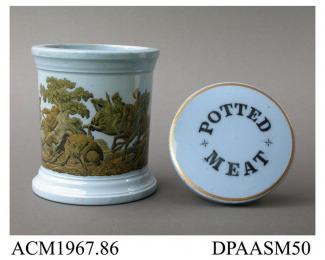Potted meat jar, with lid, blue-stained stoneware, the lid with printed inscription POTTED MEAT, the jar decorated with a depiction of a boar hunt in a stippled engraving superimposed on a conforming printed yellow ground; printed registered design marks on both jar and lid with encoded date of 18th August 1871, made by F and R Pratt and Co, Fenton, Stoke-on-Trent, Staffordshire, 1871
Potted meat is a traditional way of preserving meat, used before the invention of refrigerators. The cooked, and seasoned, meat – commonly beef, chicken or game – is tightly packed into a pot or jar whilst still hot. This excludes air from the mixture, which is then covered with hot fat. The heat process kills most bacteria and moulds. As the fat cools and hardens, it forms an airtight seal, helping to preserve the food.
In Britain, the use of potted meat has been recorded since at least the 16th century. A similar process to preserve duck and geese meat was used in France and was known as confit. This process enabled meat to be kept, in a cool place, for weeks or even months and eaten when meat was scarce.
The jar was produced by F & R Pratt & Co based at the Fenton Potteries, High Street, Fenton, Staffordshire in part of the well-known “Potteries” area. The business was founded in the early 1800s by brothers Felix Edward Pratt (1813-1894) and Richard Pratt (date unknown).
The original business was started, around 1753, by their father William Pratt, a master potter, at Lane Delph in Fenton. On William’s death (1799), his widow and sons took over the business. The sons later split to form two different companies: Richard and Felix became F&R Pratt & Co. whilst William and John formed J & W Pratt.
During the Victorian era, F & R Pratt saw a commercial opportunity to produce multi-coloured lids and pots which could be used for food products, toiletries and cosmetics amongst other uses. This was an early form of advertising. The idea was that an appealing picture on the lid would attract more customers. A talented, self-employed artist and engraver, Jesse Austin (1806-1879), joined the business around 1843. It has been noted that Jesse Austin used famous paintings, paintings of royalty, city scenes and events, as inspiration for his work as he lacked imagination despite his talent. The lids were produced by Austin painting a watercolour design which was then etched onto a copper plate. Three colour plates were produced along with a fourth black plate. The two men worked together for over 30 years, producing a vast array of pottery, including the jars and lids, known today as Staffordshire pot lids.
F & R Pratt and Co. were one of the 13,000 exhibitors at the 1851 Great Exhibition (also known as the Crystal Palace Exhibition). During its opening, from May until October, around six million people attended the event in Hyde Park, London. It was the first in a series of World Fairs – organised by Prince Albert- to showcase the culture and industry of the age. The company produced a series of ‘Exhibition Pieces’, with the best examples of their pictures embellished with a wide gold band.
Prattware – as it became known- became collectable after an exhibition in Blackpool, in 1897 , three years after Felix’s death. The first public auction for this decorative pottery occurred in 1924.
Written by Karen Stewart, Ceramic Research Volunteer



